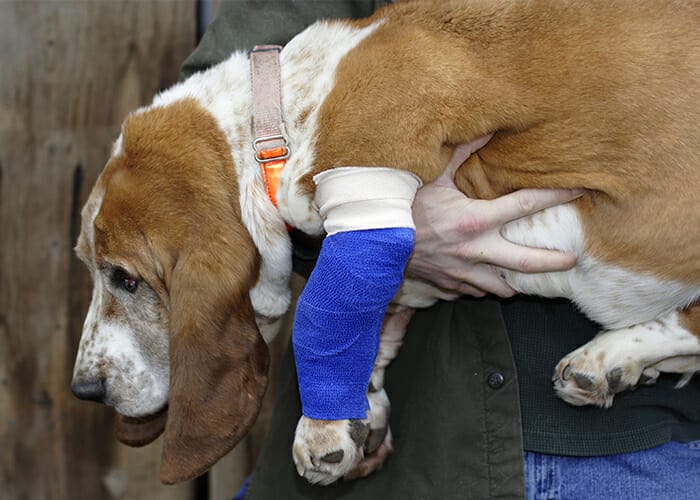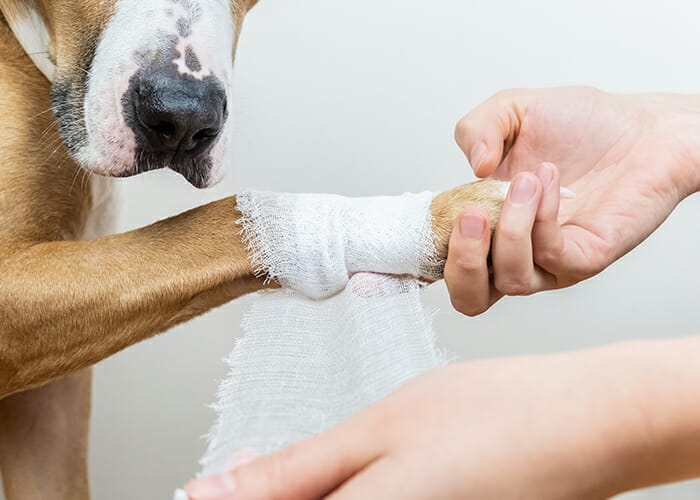Emergency Medicine, Urgent Care
Pet First Aid – Understanding the Basics to Help Your Pet

Would you know what to do to help your pet in a medical emergency? Would you be prepared if your pet was bleeding, ingested a toxic substance, or worse? Calm and quick action can make a difference in stabilizing your pet until you get emergency care. You can be prepared with some pet first aid basics before an issue arises with the tips below. Please keep in mind, this article is intended to inform you and is in no way a substitute for veterinary care.
Important Pointers for Pet First Aid
The most important thing when discussing pet first aid may be one of the last things we think about…safety. Consider that when a pet is hurting or in distress, they can’t tell you what hurts. Instead, it is common that they try to bite as a warning that they are in pain. Remember, PERSONAL SAFETY is the most important part of pet first aid.
In addition to personal safety, there are three important reminders pertaining specifically to pet first aid.
- Do not give your pet human medication. This includes common over–the–counter medications such as ibuprofen, acetaminophen, and naproxen to name a few. These are not intended for animal use and can cause severe damage to your pet’s internal organs.
- Do not give your pet another pet’s medication. While it may seem like a good idea, medications that were not prescribed to your pet can have multiple complications. One example is that it limits what a veterinarian can safely prescribe to your pet due to possible interactions. Another example is that the medications are often outdated or not appropriate for a pet’s size.
- Remain calm. This may be the most difficult part of pet first aid as our instinct may be to panic. Remember, with a little practice and by having an action plan prepared in case of emergency, you can increase the odds of remaining calm.
Bleeding
One of the most common issues we see in the emergency room is bleeding. Pets can get cuts from other animals, items in their environment, and traumatic events like being hit by a car. Remember, if your pet is in pain, they may try to bite, so it is extremely important that you are not only calm, but safe.
When your pet is secure, use a clean towel, cloth, or blanket to apply pressure to the site that is bleeding. If available, you may also apply gauze and lightly wrap the area with an adhesive bandage as you make your way to your local emergency veterinary hospital. The doctors and nurses will examine your pet thoroughly. Often, you may think there are only one or two bleeding sites when there are more under the fur.

Eating Dangerous Items
Potential toxins can be anywhere in your pet’s environment including human foods, medications, household chemicals, and even plants. If you suspect that your pet has ingested something, call your family veterinarian immediately.
If you are able, bring the packaging of the ingested item with you and/or take a picture of the ingredients. Your pet’s veterinarian will want to know the details of what, when, and how much your pet consumed. Additionally, keep track of your pet’s behavior, paying particular attention to any changes since consuming the toxin. Depending on what was consumed, you may be asked to contact a pet poison control center. If this happens, you will receive a case number when you call. Be sure to write this number down to give to your veterinarian.
Beyond toxic items, pets can be curious and will sometimes chew or even consume things that are harmful to them. Popular items include socks, underwear, shoes, and children’s toys. Any of these items can cause an obstruction in your pet. Keep in mind that some common foods are also dangerous for pets and should be kept away such as grapes, raisins, chocolate, onions, and macadamia nuts.
Insect Bites & Stings
Insect bites and stings can happen at any time of the year, especially in warmer climates. Ants, bees, and spiders are some of the common pests that can sting and bite your pets. If you suspect your pet has been stung, calmly approach your pet, remembering to keep yourself safe.
If you can see a stinger, never use tweezers or your fingers to remove it from your pet. The action of pinching or grabbing can release more irritants in your pet or even you. Instead, contact your veterinarian for further care. They know you, your pets, and the pests in your area and can advise you further for best care.
If your pet has a severe allergic reaction, seek care immediately and do not wait. Symptoms can include swelling of the face and neck, hives, rash, and itching.

Heatstroke
Heatstroke is a serious condition and should not be ignored. Emergency veterinarians see this frequently with pets – especially in the summer or in areas with warmer climates. Heat stroke can occur when pets have excessive periods of exercise in the sun with no access to shade or water. Another high occurrence of heat stroke occurs when pets are left in cars during the warmer months.
Pets experiencing heat stroke will exhibit signs such as drooling, panting, vomiting, diarrhea, loss of consciousness, uncoordinated movement, or even collapse. If you think your pet is suffering from heat stroke, there are proactive steps you can take as you make your way to your veterinarian.
If you are able, hose your pet in LUKEWARM water. Our instincts tell us to use cold water but, in this instance, lukewarm water is best. When a pet experiences heat stroke, they cannot regulate their body temperature and cold water can drop their temperature too low. As you make your way to your closest emergency veterinarian, put the air conditioner on in your car to help slowly cool your pet.
Seizures
Pets that are having seizures or seizure–like activity cannot control themselves and may unknowingly bite. While the event can be alarming and scary to witness, NEVER stick your hands in your pet’s mouth. You may think you are helping your pet breathe, but it is unnecessary and can be very dangerous.
Never restrain your pet. Our instinct as pet parents is to scoop our pets into our lap to comfort and restrain them. This can result in pets biting, scraping, or even falling. Instead, move them away from anything that could harm them like furniture or steps. You can also remove as much outside stimulus as possible. This includes dimming the lights, restricting people and other pets from the room, and keeping the house quiet. These actions may help your pet by providing a calm environment while the seizure is happening and as they regain consciousness.
Record the length of the seizure and what the pet is doing during that time. This information will be helpful to your veterinarian. Then seek veterinary care after your pet regains consciousness. Remember to be calm as your pet may be quite confused as to what happened. However, if the seizure lasts more than five minutes, seek veterinary care immediately while remembering to use the safety tips above. You can learn more about seizures and download a seizure tracking sheet in this post.
Being Prepared for Pet First Aid
Pet first aid emergencies can happen at any time. When they do, being prepared can help you provide the best care for your pet.
- Stay calm so you can think clearly and get your pet to emergency care in the safest way possible.
- Program your veterinarian’s office phone number into your phone now. This can save valuable time.
- Know where your closest animal emergency hospital is located and have their number in your phone. Sometimes, pet emergencies happen after hours and your local animal emergency will be there to help.
- Have a pet first aid kit available. Learn what to include a pet first aid kit.